
German submarine U-234 was a Type XB U-boat of Nazi Germany's Kriegsmarine during World War II, she was commanded by Kapitänleutnant Johann-Heinrich Fehler. Her first and only mission into enemy or contested territory consisted of the attempted delivery of uranium oxide and German advanced weapons technology to the Empire of Japan. After receiving Admiral Dönitz' order to surface and surrender and of Germany's unconditional surrender, the submarine's crew surrendered to the United States on 14 May 1945.
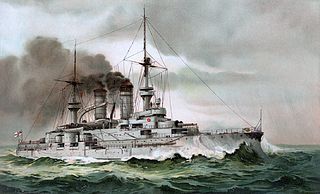
SMS Zähringen was the third Wittelsbach-class pre-dreadnought battleship of the German Imperial Navy. Laid down in 1899 at the Germaniawerft shipyard in Kiel, she was launched on 12 June 1901 and commissioned on 25 October 1902. Her sisters were Wittelsbach, Wettin, Schwaben and Mecklenburg; they were the first capital ships built under the Navy Law of 1898, brought about by Admiral Alfred von Tirpitz. The ship, named for the former royal House of Zähringen, was armed with a main battery of four 24 cm (9.4 in) guns and had a top speed of 18 knots.

BAPArica(SS-36) is one of two Type 209/1100 submarines ordered by the Peruvian Navy on 24 June 1970. She was built by the German shipbuilder Howaldtswerke Deutsche Werft AG at its shipyard in Kiel. She is named after the naval battle of Arica, an engagement between naval forces of Peru and Chile on 7 June 1880. Following sea trials in the North Sea, she arrived to its homeport of Callao in 1975. After almost a decade in service she was overhauled in Kiel between 1983 and 1984 for further use.
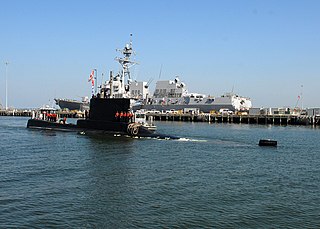
BAP Angamos (SS-31) is one of two Type 209/1200 submarines ordered by the Peruvian Navy on August 12, 1976. She was built by the German shipbuilder Howaldtswerke Deutsche Werft AG at its shipyard in Kiel. She was originally named Casma after a battle which took place between naval forces of Peru and Chile on January 12, 1839. Following sea trials in the North Sea, she arrived to its homeport of Callao in 1981. After a major overhaul by Servicio Industrial de la Marina at Callao SIMA in 1998, she was renamed Angamos after the battle of the same name which took place on October 8, 1879.
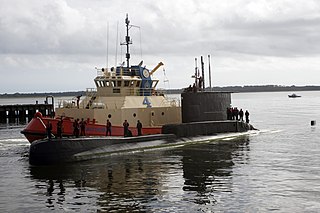
BAP Antofagasta is one of two Type 209/1200 submarines ordered by the Peruvian Navy on 12 August 1976. She was built by the German shipbuilder Howaldtswerke Deutsche Werft AG at its shipyard in Kiel. She is named after the Naval Battle of Antofagasta during the War of the Pacific. Following sea trials in the North Sea, she arrived at its homeport of Callao in 1981. After several years in service she was overhauled by Servicio Industrial de la Marina (SIMA) at Callao in 1996.

BAPPisagua(SS-33) is one of two Type 209/1200 submarines ordered by the Peruvian Navy on 21 March 1977. It was built by the German shipbuilder Howaldtswerke Deutsche Werft AG at its shipyard in Kiel. It is named after the battle of Pisagua which took place between Chilean warships and Peruvian coastal artillery on 2 November 1879. While undergoing sea trials in the North Sea, it collided with a Soviet ship on 8 April 1982 and suffered damage which delayed its commissioning. It eventually arrived to its homeport of Callao in 1983.

BAPChipana(SS-34) is one of two Type 209/1200 submarines ordered by the Peruvian Navy on March 21, 1977. She was built by the German shipbuilder Howaldtswerke Deutsche Werft AG at its shipyard in Kiel.

SMS Moltke was a Bismarck-class corvette built for the German Imperial Navy in the late 1870s. The ship was named after the Prussian Field Marshal Helmuth von Moltke the Elder. She was the fourth member of the class, which included five other vessels. The Bismarck-class corvettes were ordered as part of a major naval construction program in the early 1870s, and she was designed to serve as a fleet scout and on extended tours in Germany's colonial empire. Moltke was laid down in July 1875, launched in October 1877, and was commissioned into the fleet in April 1878. She was armed with a battery of ten 15 cm (5.9 in) guns and had a full ship rig to supplement her steam engine on long cruises abroad.
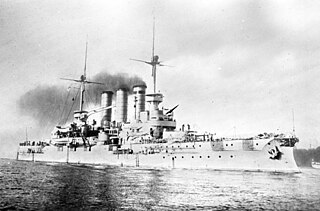
SMS Braunschweig was the first of five pre-dreadnought battleships of the Braunschweig class built for the German Kaiserliche Marine. She was laid down in October 1901, launched in December 1902, and commissioned in October 1904. She was named after the Duchy of Brunswick. The ship was armed with a battery of four 28 cm (11 in) guns and had a top speed of 18 knots. Like all other pre-dreadnoughts built at the turn of the century, Braunschweig was quickly made obsolete by the launching of the revolutionary HMS Dreadnought in 1906; as a result, her career as a front-line battleship was cut short.

SMS Kaiser Friedrich III was the lead ship of the Kaiser Friedrich III class of pre-dreadnought battleships. She was laid down at the Kaiserliche Werft in Wilhelmshaven in March 1895, launched in July 1896, and finished in October 1898. The ship was armed with a main battery of four 24-centimeter (9.4 in) guns in two twin gun turrets supported by a secondary battery of eighteen 15 cm (5.9 in) guns.

SMS Kaiser Karl der Grosse was a German pre-dreadnought battleship of the Kaiser Friedrich III class, built around the turn of the 20th century for the Kaiserliche Marine. Named for the Emperor Charlemagne, Kaiser Karl der Grosse was built in Hamburg, at the Blohm and Voss shipyard. She was laid down in September 1898 and launched in October 1899. A shipyard strike and an accidental grounding delayed her completion until February 1902; she was therefore the last member of her class to enter service. The ship was armed with four 24-centimeter (9.4 in) guns in two twin gun turrets and had a top speed of 17.5 knots.
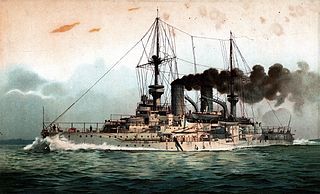
SMS Mecklenburg was the fifth ship of the Wittelsbach class of pre-dreadnought battleships of the German Imperial Navy. Laid down in May 1900 at the AG Vulcan shipyard in Stettin, Germany, she was finished in May 1903. Her sister ships were Wittelsbach, Zähringen, Wettin, and Schwaben; they were the first capital ships built under the Navy Law of 1898, championed by Admiral Alfred von Tirpitz. Mecklenburg was armed with a main battery of four 24-centimeter (9.4 in) guns and had a top speed of 18 knots.

SMS Kaiser Wilhelm der Grosse was a German pre-dreadnought battleship of the Kaiser Friedrich III class, built around the turn of the 20th century. The ship was one of the first battleships built by the German Imperial Navy as part of a program of naval expansion under Kaiser Wilhelm II. Kaiser Wilhelm der Grosse was built in Kiel at the Germaniawerft shipyard. She was laid down in January 1898, launched in June 1899, and completed in May 1901. The ship was armed with a main battery of four 24-centimeter (9.4 in) guns in two twin turrets.

SMS Wittelsbach was the lead ship of the Wittelsbach class of pre-dreadnought battleships, built for the Imperial German Navy. She was the first capital ship built under the Navy Law of 1898, brought about by Admiral Alfred von Tirpitz. Wittelsbach was laid down in 1899 at the Wilhelmshaven Navy Dockyard and completed in October 1902. She was armed with a main battery of four 24 cm (9.4 in) guns and had a top speed of 18 knots.

SMS Kolberg was a light cruiser of the German Kaiserliche Marine during the First World War, the lead ship of her class. She had three sister ships, SMS Mainz, Cöln, and Augsburg. She was built by the Schichau-Werke; her hull was laid down in early 1908 and she was launched later that year, in November. She was commissioned into the High Seas Fleet in June 1910. She was armed with a main battery of twelve 10.5 cm SK L/45 guns and had a top speed of 25.5 kn.

SMS Berlin was the second member of the seven-vessel Bremen class of light cruisers, built for the German Kaiserliche Marine in the early 1900s. She and her sister ships were ordered under the 1898 Naval Law that required new cruisers be built to replace obsolete vessels in the fleet. The design for the Bremen class was derived from the preceding Gazelle class, utilizing a larger hull that allowed for additional boilers that increased speed. Named for the German capital of Berlin, the ship was armed with a main battery of ten 10.5 cm (4.1 in) guns and had a top speed of 22 knots.

SMS Hansa was a German ironclad warship built in 1868–1875. She was the first ironclad built in Germany; all previous German ironclads had been built in foreign shipyards. She was named after the Hanseatic League, known in Germany simply as Hanse, Latinized Hansa. The ship was launched in October 1872 and commissioned into the German Imperial Navy in May 1875. Designed for overseas service, Hansa was classed as an armored corvette and armed with eight 21 cm (8.3 in) guns in a central battery.

SMS Stein was a Bismarck-class corvette built for the German Imperial Navy in the late 1870s. The ship was named after the Prussian statesman Heinrich Friedrich Karl vom und zum Stein. She was the sixth member of the class, which included five other vessels. The Bismarck-class corvettes were ordered as part of a major naval construction program in the early 1870s, and she was designed to serve as a fleet scout and on extended tours in Germany's colonial empire. Stein was laid down in 1878, launched in September 1879, and was commissioned into the fleet in October 1880. She was armed with a battery of twelve 15 cm (5.9 in) guns and had a full ship rig to supplement her steam engine on long cruises abroad.
The Battle of Islay occurred on January 12 and 13, 1838, during the War of the Confederation between Chile and the Peru–Bolivian Confederation.

SMS Freya was a steam corvette of the German Kaiserliche Marine. She was the third member of the Ariadne class, which included two other ships, Ariadne and Luise. Ordered as part of a large naval expansion program after the Austro-Prussian War, she was laid down in 1872 after the Franco-Prussian War. She was launched in December 1874 and completed in October 1876. Freya was built to a different design than her sisters, being longer and carrying a heavier battery of twelve guns.



















